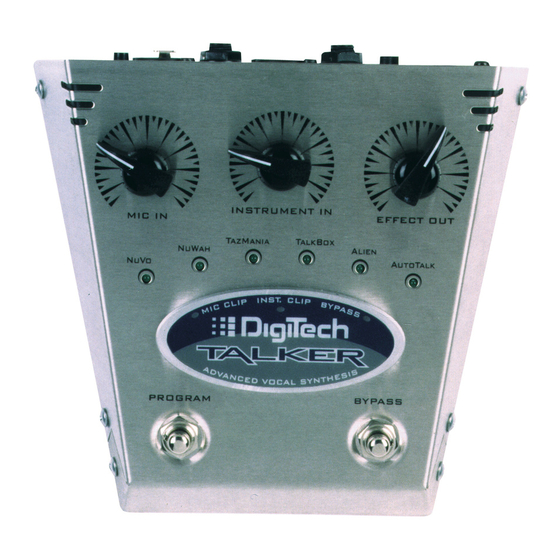DigiTech TALKER Manual do utilizador - Página 6
Procurar online ou descarregar pdf Manual do utilizador para Hardware informático DigiTech TALKER. DigiTech TALKER 7 páginas.

Program Descriptions:
• NuVo: This is the most intelligible program. Play a chord and
speak or sing into the mic and you will be able to hear the words
clearly.
• NuWah: (Guitar effect only, no vocal needed). This is an auto-
matic wah feature that is somewhat like an envelope follower but
the wah is very human sounding.
• TazMania: (Use instrument and mic, or mic alone). This pro-
gram uses white noise to generate a devilish voice. The gate fea-
ture is active so that the user can switch back and forth between
the effect and the guitar sound without pressing the Bypass
switch.
• TalkBox: This program features vocoder which has been EQ'd
to sound more like the old Talkboxes such as the "Golden
Throat", Heil "Talk Box", etc.
• Alien: This program features an old style vocoder or alien
sounding effect.
• AutoTalk: This is an automatic vocoder-type effect. Play your
guitar with the effect on (you'll hear the normal guitar sound),
then sing or say something into the mic. This will automatically
switch into the AutoTalk effect. When you finish vocalizing, the
Talker will automatically switch back to your guitar sound.
6
Some Suggested Applications:
Guitar & Microphone With Distortion:
One way to set up when you are using guitar and some effects is to
place your Talker after the distortion or compression effects. Using
distortion with a guitar into the Talker can increase intelligibility and
sustain. Other effects such as echo, reverb, phaser and flanger, should
be added after the Talker.
Drum Machine Loop:
Run the left and right outputs of a drum machine into the Mic Input
and the Instrument Input of the Talker. Set the input levels and adjust
the Effect Output. You may need a 1/4" to XLR cable adapter for the
Mic In. Try taking drums with different rhythms and panning them
hard left and hard right to hear them modulate against each other.
Keyboard/Drum Machine:
Connect a synthesizer or sampler to the Instrument Input and a drum
machine into the Mic Input to achieve a rhythmic keyboard effect. Try
using a sustained string or pad type of keyboard sound. Also try mod-
ulating a sustaining bass sound or a sub-bass waveform with just the
bass drum output of a drum machine or a recorded bass or bass drum
track.
Bass/Vocal:
Same set-up as a guitar. For maximum effect use distortion or com-
pression effects before the Talker Input.
Pre-recorded loop:
Run the stereo outputs of a CD or tape player into the Mic Input and
the Instrument Input of the Talker. Set the Input levels and adjust the
Effect Output. You may need a 1/4" to XLR cable adapter for the Mic
Input.
Recorded tracks:
If you have a multi-track recorder, experiment with using pre-recorded
vocal or instrumental tracks as either the Mic or Instrument inputs, as
well as against live mic or instrument input, to generate new effect
tracks.
Note: The general rule of thumb is that the sound source that has
more sustained notes and a wider frequency signal should be in the
Instrument input, and the source that has more rhythmic variation or
expressive changes in volume and timbre should be in the Mic input.
7
